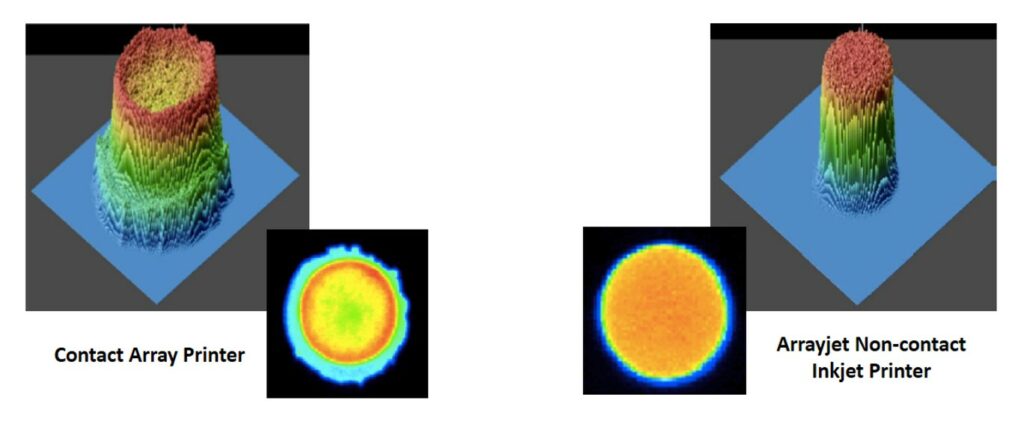Microarray printing is increasingly pivotal in the life sciences sector, allowing researchers to analyze vast amounts of biological data simultaneously. This technology has paved the way for advancements in genomics, proteomics, and other fields. At the heart of this innovation are various microarray printing methods, each offering unique advantages and applications.
List of content
Contact Printing vs Inkjet Printing
Contact Printing: The Direct Approach
Contact printing is a foundational method in microarray technology. It involves a direct interaction between the printing pin or stamp and the solid substrate, typically a glass slide. By coating the pin with the desired biological sample, it transfers the material onto the slide in a predetermined pattern. While this method boasts simplicity and cost-effectiveness, challenges arise in controlling the uniformity of the spots and the precise amount of material transferred. The risk of cross-contamination is also a concern.
Inkjet Printing: Precision in Droplets
Inkjet printing is renowned for its precision and adaptability, particularly in depositing biological samples onto solid substrates. Typically, droplets are generated piezoelectrically, allowing for exact control over their size, shape, and placement. However, this precision often comes with higher costs due to the need for specialised equipment. Various alternative methodologies exist within the inkjet printing space, such as glass tip printing and on-the-fly inkjet printing, each with unique applications.
To understand the advantages of inkjet printing, it’s helpful to differentiate between contact and contactless printing techniques.
- Contact printing, exemplified by pin-spotting, involves direct contact between the printing device and the substrate. This method has limitations, such as potential cross-contamination and surface damage, and struggles with higher-viscosity samples.
- Contactless printing, which includes technologies based on glass tips, overcomes these limitations by enabling deposition without physical contact with the surface. This approach minimises cross-contamination and surface damage, making it suitable for a wider range of applications. Contactless printing also has substantial benefits in deposition speed.

Arrayjet’s inkjet technology distinguishes itself significantly from glass tip-based systems. We offer substantial advantages in terms of throughput, boasting up to tenfold and hundredfold increases in printing speed compared to glass tips and pin-spotting, respectively. The robust nature of our commercial inkjet heads contrasts the fragility and higher replacement costs associated with glass tips and pins. Moreover, we allow for instant customisation of print layouts, and sample deposition volumes, a feature not available with the fixed layouts of pin-spotting and the limited flexibility of glass tips. Furthermore, its compatibility with most biological samples, including small molecule drugs, positions our system as a versatile tool in scenarios where other methods falter.
The Future of Microarray Printing: A Glimpse into Arrayjet’s Offerings
Microarray printing’s potential is vast, with the ability to print thousands of samples on compact surface areas. This high-throughput analysis capability has enhanced our understanding of gene expression, protein-protein interactions, and countless other biological processes. It is also opening avenues in drug discovery, particularly in the search for valuable therapeutics. This method’s high-throughput capability makes it ideal for large-scale printing runs, thus increasing productivity.
Arrayjet’s patented microarray printing, for instance, employs an inkjet printhead to deposit picoliter droplets of liquid samples onto surfaces. Its non-contact nature ensures the printhead never touches the surface, making it ideal for delicate substrates like nitrocellulose or hydrogel.
At Arrayjet, we consider ourselves frontrunners in the microarray printing arena. Our state-of-the-art printers, leveraging inkjet technology, are apt for a wide range of sample types and high-throughput array output. The benefits of inkjet printing include:
- High Precision and Accuracy: Ensuring consistent and reliable results.
- Non-contact Printing: Enhancing speed and spot morphology.
- High Throughput: Facilitating large number printing runs in record time.
- Flexibility: Can print diverse biological samples, including DNA, proteins, small molecules, glycans, and cell lysates onto a wide range of surfaces and microfluidics devices.
In essence, Arrayjet’s inkjet microarray printing is unique with its non-contact, precise droplet deposition. Our offerings, with their cutting-edge technology, are setting new standards in the field. Interested in learning more? Contact us today.
References:
- Lin J, Bardina L, Shreffler WG. Microarrayed allergen molecules for diagnostics of allergy. Methods Mol Biol. 2009;524:259-72. doi: 10.1007/978-1-59745-450-6_19. PMID: 19377951.
- Bennet, F., Burr, L., Schmid, D., & Hodoroaba, V. (2021). Towards a method for quantitative evaluation of nanoparticle from suspensions via microarray printing and SEM analysis. Journal of Physics: Conference Series, 1953.
- Shaqour, B., Abuabiah, M., Abdel-Fattah, S., Juaidi, A., Abdallah, R., Abuzaina, W., Qarout, M., Verleije, B., & Cos, P. (2021). Gaining a better understanding of the extrusion process in fused filament fabrication 3D printing: a review. The International Journal of Advanced Manufacturing Technology, 114, 1279 – 1291.
- Banerjee AK, Ghosh S, Mal C. Identification of Culprit Genes for Different Diseases by Analyzing Microarray Data. Methods Mol Biol. 2024;2719:167-180. doi: 10.1007/978-1-0716-3461-5_10. PMID: 37803118.
- Pal, R., & Basak, A. (2022). Linking Powder Properties, Printing Parameters, Post-Processing Methods, and Fatigue Properties in Additive Manufacturing of AlSi10Mg. Alloys.
- Gillett D, Bashari W, Senanayake R, Marsden D, Koulouri O, MacFarlane J, van der Meulen M, Powlson AS, Mendichovszky IA, Cheow H, Bird N, Kolias A, Mannion R, Gurnell M. Methods of 3D printing models of pituitary tumors. 3D Print Med. 2021 Aug 31;7(1):24. doi: 10.1186/s41205-021-00118-4. Erratum in: 3D Print Med. 2021 Nov 17;7(1):37. PMID: 34462823; PMCID: PMC8406959.

